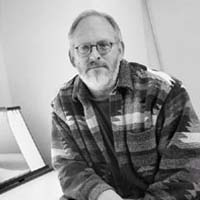


Member, Freestyle Advisory Board of Photographic Professionals
Huntington Witherill was born in Syracuse, New York, in 1949. He moved to California in 1953 and began training in classical music. Upon entering college as a music major, Witherill become interested in the study of two-dimensional design. This shift in artistic medium eventually led to a career in fine art photography beginning in 1970. He studied under such notables as Ansel Adams, Wynn Bullock, Steve Crouch, and Al Weber.
Witherill's photographs have been exhibited in more than seventy-five individual and group exhibitions in museums and galleries throughout the world. His photographs represent a remarkably varied approach to the medium including landscapes, studies of pop-art, botanical studies, urban architecture and digital imaging.
"For more than thirty years I have used a camera and lens to chronicle my intense fascination with the symbolic and often transient visual relationships of line, form, and space," says Mr. Witherill. " I have always endeavored to approach each subject before my camera - not simply to record an object in and of itself, but rather to create images that symbolize and celebrate those inherent visual qualities that are by nature universal to all matter."

In 2000, an international acclaimed hard bound monograph featuring
Witherill's black and white landscape images, entitled: "Orchestrating
Icons", was published followed by a second award winning hard bound
monographs featuring his black and white botanical photographs,
entitled "Botanical Dances", in 2001.
Witherill likens his thirty-year career as a fine art photographer
to a creative odyssey, a journey of limitless artistic discovery
in which the artist seeks no final destination and draws upon the
past as a guide toward the future. .
"The only way I can see where I'm going is to look at what I've
done in the past," he explains. "It is like driving down the road
using only the rear view mirror as a point of reference to give
a hint where I'm headed. One of the greatest things about all art
is that one will never quite figure out how to do it. It's a lifelong
thing." .
Since having been the recipient of the Artist of the Year award
presented by the Center for Photographic Art, in 1999, Witherill
continues the expand his photographic vision. Beginning in 2002,
he produced a remarkable series of botanical images using color
materials and the digital imaging realm. With these new tools, Witherill
has produced a body of work representing a creative and new approach
to the medium.

For Witherill, working with computer imaging technologies
has given him greater creative control and freedom, while staying
faithful to the high standards of the "fine print" espoused by Ansel
Adams.
"What the computer gives you is unlimited control of the contrast
and tonal range," notes Witherill. "The process allows me to get
a more refined resolution to the image."
Since 1975, Witherill has continued to teach photography for a variety
of institutions and workshops programs throughout the United States,
including the University of California, Friends of Photography,
and The Ansel Adams Gallery. He and his wife make their home in
Monterey, CA.